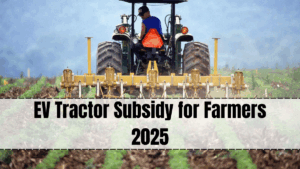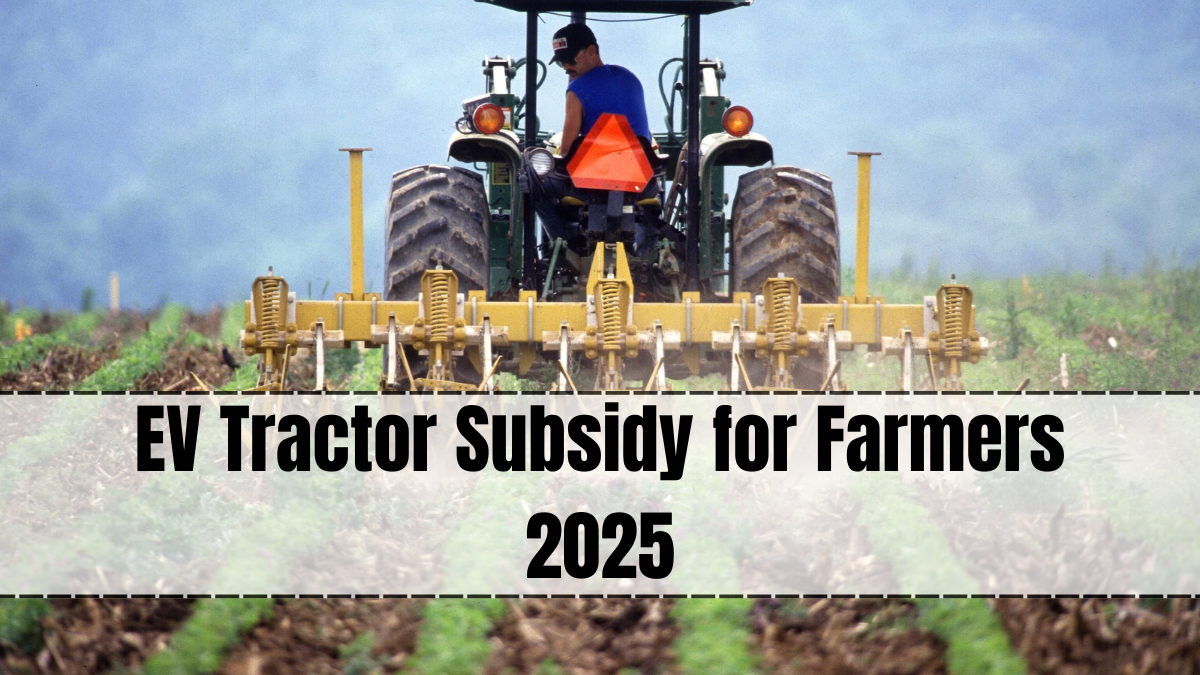In 2025, the Government of India has taken a significant step towards sustainable agriculture by introducing the EV Tractor Subsidy Scheme. This initiative encourages farmers to adopt electric tractors, reducing dependency on diesel, cutting operational costs, and lowering carbon emissions. With agriculture contributing to a large share of India’s energy consumption, this move aligns with the country’s broader climate goals and green energy policies.
The scheme offers attractive subsidies, easy financing options, and technical support, making electric tractors an affordable and practical choice for both small and large-scale farmers.

Why Electric Tractors are a Game-Changer in Agriculture
Switching to EV tractors benefits farmers and the environment in multiple ways:
-
Lower Operating Costs – Electricity is cheaper than diesel, leading to long-term savings.
-
Reduced Maintenance – Fewer moving parts mean lower repair and servicing expenses.
-
Eco-Friendly Farming – Zero tailpipe emissions contribute to cleaner air and healthier soil.
-
Improved Efficiency – Advanced battery technology ensures consistent performance.
With the government’s subsidies, these benefits are now more accessible to rural farmers across India.
Key Features of the EV Tractor Subsidy Scheme 2025
The EV Tractor Subsidy Scheme is designed to remove financial barriers and accelerate adoption:
-
High Subsidy Rates – Up to 40–50% of the tractor’s cost covered by the government.
-
Easy Loan Options – Partnerships with rural banks and cooperatives for low-interest loans.
-
Battery Replacement Support – Subsidized battery exchange programs to reduce future costs.
-
Training Programs – Free workshops on electric tractor operation and maintenance.
-
State-Level Incentives – Additional subsidies from state governments in certain regions.
This comprehensive support ensures that farmers can transition to EV tractors without financial strain.
Role in Promoting Green Farming Practices
The EV tractor subsidy directly contributes to India’s green farming goals:
-
Encourages sustainable agriculture by reducing greenhouse gas emissions.
-
Supports renewable energy integration by charging tractors through solar-powered stations.
-
Promotes mechanization in small and medium farms without increasing environmental damage.
With the combination of subsidies and awareness programs, farmers are more motivated to adopt eco-friendly practices.
Economic and Social Benefits for Farmers
Beyond environmental gains, EV tractors offer strong financial and social advantages:
-
Higher Profit Margins – Reduced fuel and maintenance costs increase net income.
-
Time Savings – Faster operations mean more productive farming cycles.
-
Better Credit Access – Participation in the scheme can improve eligibility for other agricultural loans.
-
Community Upliftment – Shared use of electric tractors among farmers promotes cooperation.
This initiative ensures that sustainable farming is also profitable farming.
Challenges in Implementation
While the EV Tractor Subsidy Scheme is promising, some challenges remain:
-
Charging Infrastructure – Many rural areas still lack accessible charging stations.
-
Battery Life Concerns – Farmers worry about replacement costs after several years of use.
-
Awareness Levels – Some farmers are hesitant to switch from conventional tractors.
-
Upfront Costs – Even after subsidies, initial investment may be high for marginal farmers.
To address these, the government is working with agriculture cooperatives and NGOs to improve outreach and infrastructure.
Future of Electric Tractors in India
By 2030, the adoption of EV tractors is expected to grow significantly:
-
Smart Farming Integration – GPS and AI-powered tractors for precision agriculture.
-
Solar-Powered Charging Stations – Reducing dependency on grid electricity.
-
Battery Swapping Models – Eliminating downtime due to charging.
-
Wider Range of Models – From compact tractors for small farms to high-power machines for large fields.
The EV tractor subsidies introduced in 2025 will serve as the foundation for this long-term transformation.
Final Thoughts
The EV Tractor Subsidy for Farmers 2025 marks a turning point in Indian agriculture. By combining financial incentives with technological innovation, the scheme ensures that electric tractors are no longer a luxury but an achievable reality for farmers across the nation.
With benefits ranging from reduced costs to improved sustainability, the future of farming in India is set to become greener, cleaner, and more profitable.
FAQs
How much subsidy is offered under the EV Tractor Subsidy Scheme 2025?
Farmers can receive up to 40–50% subsidy on the purchase price of electric tractors.
Do farmers need to repay the subsidy amount?
No, the subsidy is a direct financial incentive provided by the government.
Is the scheme available for all types of farms?
Yes, the scheme covers small, medium, and large farms, with specific models suited for each.
How can farmers charge their electric tractors in rural areas?
The government is setting up charging stations and promoting solar-powered chargers in villages.
Will EV tractors have enough power for heavy farm work?
Yes, modern electric tractors are designed to match or even exceed the performance of diesel models.
Click here to know more.
